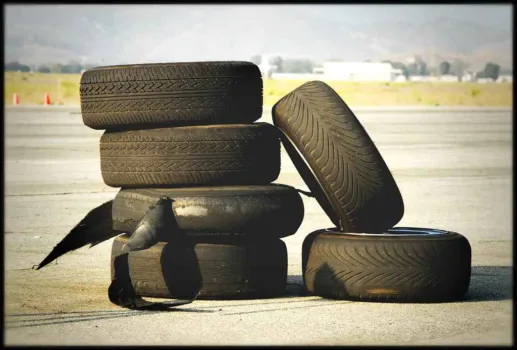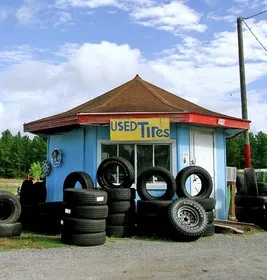
Many people (myself included) buy used tires. After all, that’s one way to save money, right?
It’s also another way to practice a green lifestyle since you’re reusing something.
However, this might be one time when reusing an item is not in your best interest. The fact is, old tires simply may not be as safe as new tires — whether they’ve been used or not.
After a tire is older than 6 years, there is an increased risk that that tire is going to suffer a catastrophic tread separation:
Following are some of the dangers associated with buying used tires — or even OLD, unused tires! Plus, how to make sense of the letters and numbers on your tire’s sidewall and determine the true age of your tires.
Used Tires vs Old Tires
- Used tires may look good when you buy them, the tread may even look fine, but they can blow while you are driving and cause an accident. This happened to one family who purchased one new tire for their van before going on vacation. Their van actually crashed!
- A used tire may look good on the outside, but its internal area could be seriously damaged. Just because a tire looks okay, does not mean that it is.

- You don’t know where a used tire came from. Used tires, generally speaking, are picked up from auto shops. The problem is, you don’t know if the auto shop took that tire from a car that was totaled or in a serious accident. It could be that the tire was taken from a totaled car, and there could be damage you are unaware of when you buy them.
- Used tires are barely inspected. Remember these tires are picked up from auto shops, and they go on a conveyor belt where they are only quickly inspected to make sure they have good tread and such. They are not as carefully inspected as new tires, and as such, this can leave you open to a whole range of possibilities; none of them good.
- Aged tires will always pose a threat to you. This is something that those in the industry have learned over time. No matter how good a tire may look, if it is an older tire, there is the potential for it to cause you to have an accident. Statistics are proving that the older the tire, the greater the likelihood that there will be a problem.
- Some retailers detail old tires. What this means is they are taken in and checked out, and then repainted black so that they look like brand new tires. The danger in this is obvious: since these tires look new, you would likely assume they are almost new — maybe even brand new — when, in fact, they aren’t. Since we know the age of a tire matters and can contribute to accidents this is not a good thing.
In Sum…

The fact is, 75% of tire retailers sell used tires, and they don’t want to have to stop selling them. So, until the government either regulates this business, or a better way is found to inspect new tires, it’s a good idea to stick with new tires instead.
Just remember, tire retailers also sell old tires that have never been used as “brand new” sometimes. And unless you take the time to decode the numbers on the tire’s sidewall, you may be in for a big surprise when a “new” tire fails due to age.
In this case, it’s better to error on the side of caution rather than take a chance on someone losing their life or being seriously injured after buying used tires or aged tires.
As reported in the following video from ABC News, tires have a kind of shelf life, and ignoring that could kill you!
Tires can sit on store shelves for years before they’re sold. But there’s no expiration date. Yet research and tests show that as tires get older — even if they’ve never been driven a mile — they begin to dry out, and after 6 years of age can become dangerous.
See how to decode the numbers and letters on your tire’s sidewall and determine the age of your tire.



